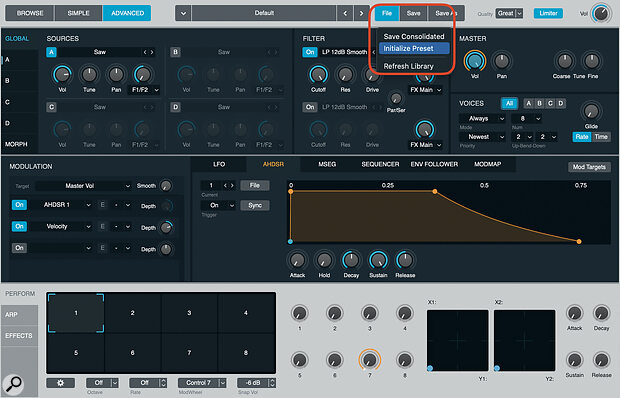 The File / Initialize Preset option will reset Alchemy and pare things down to just Source A ‑ an ideal starting point for your granular experiments.
The File / Initialize Preset option will reset Alchemy and pare things down to just Source A ‑ an ideal starting point for your granular experiments.
Alchemy’s granular engine is a sonic playground with infinite possibilities!
Who needs a gaming console when sound design offers a world of immersive experiences! If you’re ever stuck for a starting point for a new composition, you could do much worse than trying granular resynthesis in Alchemy — it can transform any scrap of audio you have lying around into a goldmine of ideas in no time.
The more you play with Alchemy (I use the word ‘play’ deliberately), the more you’ll find yourself awash with project starting points. You’ll also discover endless potential for developing and manipulating your samples.
Composer Matthew Herbert once talked of how we now have the capacity to listen to the world in different ways. I remember being very inspired by his stated intent to “freeze history, press pause, wander around inside the sound”. If you are as inspired as much as I was by that idea, you’ll relish beginning that journey with Logic Pro’s Alchemy synth.
DAWs Of Perception
While Logic’s array of virtual analogue synths (ES1, ES2, ES‑M, ES‑P, ES‑E, Retro Synth) can convincingly emulate analogue technology (whilst also offering such digital luxuries as velocity sensitivity and practically unlimited polyphony), Alchemy implements a form of synthesis that can only exist in the digital realm.
Alchemy can function as a powerful standalone synthesizer or as an advanced sampler — which, incidentally, can open any of your EXS Logic Sampler patches. But perhaps it’s best to think of it as a combination of both: a sample‑manipulation synthesizer. To begin programming, you start with at least one Source (up to four). These Sources may contain either audio files as starting points or oscillators that will generate all manner of virtual analogue waveforms, from the simple sine through to more complex shapes.
For now, let’s focus on granular resynthesis, which, like any time‑stretching algorithm, works by breaking up audio into tiny fragments called grains. In Alchemy, these grains can be reordered, shaped, pitch‑shifted, repeated, layered, and spread around the stereo field, before being recombined back into an output stream to be further manipulated, modulated, and effected in a virtually infinite number of ways.
 Setting up modulation is as easy as right‑clicking the destination and picking a source from the list.
Setting up modulation is as easy as right‑clicking the destination and picking a source from the list.
Inner...
You are reading one of the locked Subscribers-only articles from our latest 5 issues.
You've read 30% of this article for FREE, so to continue reading...
- ✅ Log in - if you have a Digital Subscription you bought from SoundOnSound.com
- ⬇️ Buy & Download this Single Article in PDF format £0.83 GBP$1.49 USD
For less than the price of a coffee, buy now and immediately download to your computer, tablet or mobile. - ⬇️ ⬇️ ⬇️ Buy & Download the FULL ISSUE PDF
Our 'full SOS magazine' for smartphone/tablet/computer. More info... - 📲 Buy a DIGITAL subscription (or 📖 📲 Print + Digital sub)
Instantly unlock ALL Premium web articles! We often release online-only content.
Visit our ShopStore.
